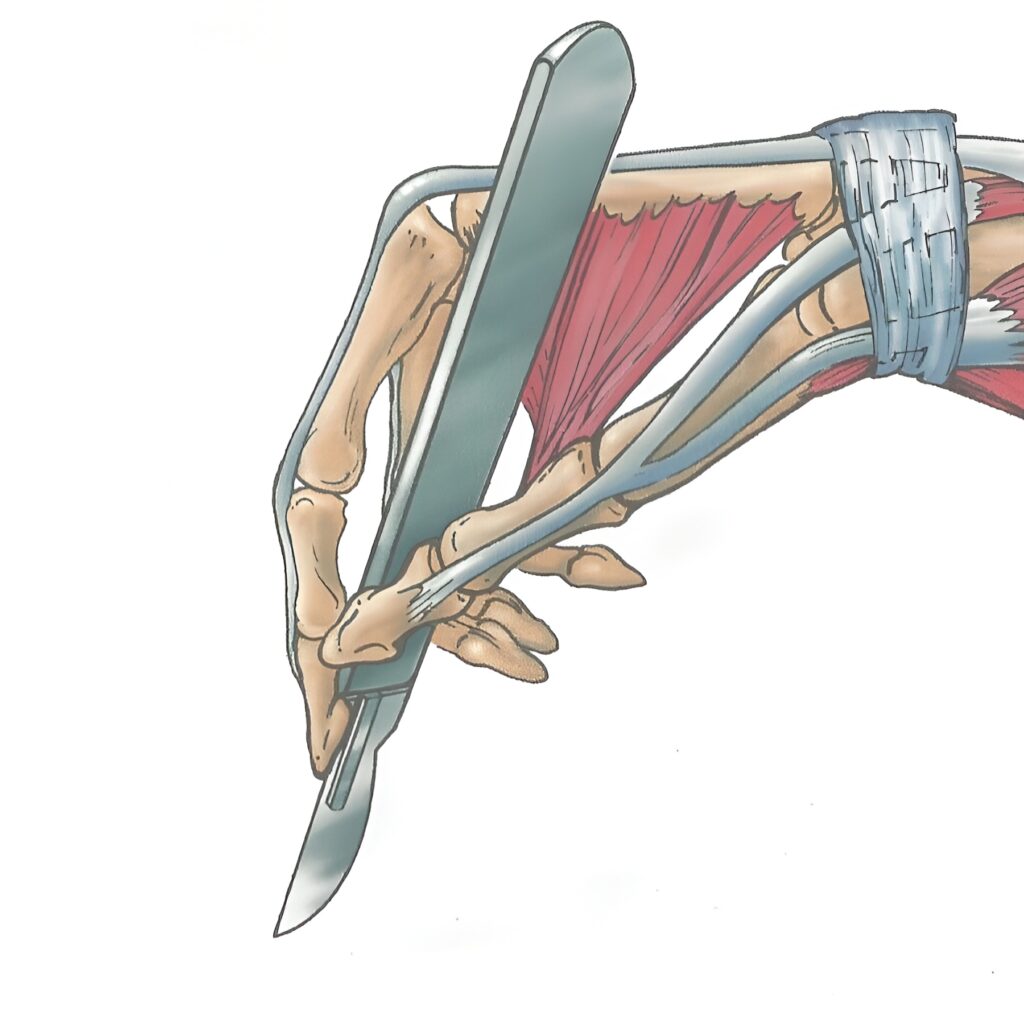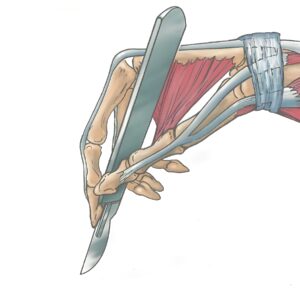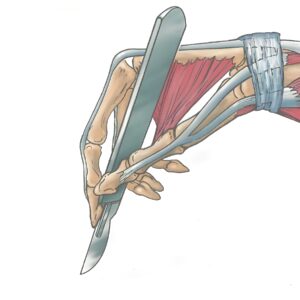
Two Types of Heart Muscle Cells
- September 15, 2025
- 2:29 pm
Summary
There are two types of heart muscle cells: contractile cells (99%, responsible for pumping) and pacing/conducting cells (SA node, AV node, bundle of His, Purkinje fibers, responsible for initiating/conducting action potentials). They are linked structurally by intercalated discs and electrically via gap junctions. The SA node sets the heart rhythm; action potentials spread to contractile cells, coordinating contraction seen in EKGs.
Raw Transcript
[00:00] Okay, we're going to talk about heart muscle cells and answer the questions, what are the two types of heart muscle cells, what links them together, and what ways do they work together? Hello everyone, my name is Dr. Morton and I'm the noted anatomist. Now there are two types of heart muscle cells also known as cardiac muscle cells or cardiomyocytes. Each of those terms are synol-
[00:20] There are the contractile cells like we see in the atria and the ventricles. Now if we take an H and E stain of a ventricle and we zoom in on it, we see the centrally located nuclei characteristic of heart muscle tissue. Also the pink cytoplasm, which is really just myosin and actin filaments, and these proteins are what
[00:40] do shing and they contract and that's what does the pumping. We also have these intercalated discs. Now contractile cardiomyocytes make up 99% of heart muscle tissue so when the action potential spreads through the heart muscle that's what is picked up on an EKG.
[01:00] we have are the pacing and conducting cells like SA and AV node, bundle of hysts, bundle branches, and the brachinje fibers. So the SA node or the sinoatrial node is the pacemaker. When it's pacing the heart it's known as the sinus rhythm for sinoatrial node. It has automaticity which means these
[01:20] generate an action potential spontaneously. And the typical pacing of the SA node is 60 to 100 beats per minute. Now we can increase that through sympathetic or decrease that through parasympathetic innervation. And the SA node is about half the size of a penny and its blood supplies through the
[01:40] sinoatrial nodal artery or SA nodal artery, a branch off the right coronary. Next we have the AV node or atrioventricular node, which is located in that interatrial septum right by the opening of the coronary sinus. Its function is it delays the atrial action potential.
[02:00] And it also has automaticity with an intrinsic rate of 40 to 50 beats per minute. The AV node is the electrical link between the atria and ventricles. Now what do we mean by that? Well in this schematic there's the AV node which is in the atrial side and the connective tissue separates the atria from the ventricle.
[02:20] Now, what is this connective tissue? That's the AV valves, like tricuspid and mitral valves. And they do not conduct an action potential. So the AV node is the electrical link down into the ventricles. So as the atrial action potential spreads down towards the AV valve, the connective tissues do not
[02:40] conduct an action potential so it stops. But that action potential activates the AV node. The AV node is the only electrical link between the atria and the ventricles. So that action potential slowly moves through the AV node into the bundle of hiss. And this is what the slow movement is what enables the
[03:00] atria to contract before the ventricles. The action potential then goes to the bundle of hysts which are cardiomyocyte cells in the interventricular septum. This what rapidly transmits the action potential from the AV node to the bundle branches, left and right bundle branches.
[03:20] It has very fast action potential conduction velocity. Then finally, the Purkinje fiber is in the subendocardial region where the action potential spreads to papillary muscles first, then the walls of the ventricle, which ensures that the AV valves remain shut.
[03:40] during systole. They also have fast action potential conduction velocity. In a nutshell, the AV node is a turtle. It's very slow action potential conduction velocity like 0.05 meters per second. This is what ensures the atrium can contract before the ventricles contract.
[04:00] contrast, the bundle of his bundle branches and brachinje fibers, they're a cheetah. Very fast action potential conduction velocity. Two to three meters per second. This is what ensures a nearly simultaneous contraction of the ventricles.
[04:20] shows these pictures where the yellow lines look like nerves, but they're not. These yellow lines are actually specialized heart muscle cells. So this bundle branch here, heart muscle cells, heart muscle cells, Purkinje fibers, they're heart muscle cells. The pacing conducting cells are not nerves, they're heart muscle cells that conduct in
[04:40] to contract. So they have less myosin and that's why they show up more pink, pardon me, less pink and more pale in an H and E stain because there's less protein. The SA node fires at 62 to 100 beats per minute. The AV node bundle of hiss and prokinje fibers also have automatic.
[05:00] but they're slower, they're subsidiary pacemakers. This hierarchy provides a safety factor should one of the pacemakers fail or the action potential cannot conduct through the AV node. So the SA node fires at 60 to 100 beats per minute, but if something happens to the SA node and it doesn't work, the AV node picks up.
[05:20] up and it then fires at 40 to 50 beats per minute. But what happens if it stops? Then the bundle of hiss and Purkinje fibers will take over. These lower pacemakers fire at a slow rate, at such a slow rate that they may not be sufficient to maintain cardiac output or blood pressure and then the patient would need to get a pacemaker in.
[05:40] inserted in an electrical pacemaker. So two types of heart muscle cells, contractile and pacing. Now how are cardiac muscle cells linked together? Well, they're linked structurally through intercalated discs and electrically via gap junctions. So here's some ventricle-
[06:00] tissue and we're going to zoom in on that intercalated disc and blow it up in the schematic to show those two adjacent cardiac muscle cells and there's an intercalated disc. It's the structural link between adjacent cardiac muscle cells. But there's also these gap junctions sometimes called connexons. That's the
[06:20] electrical link between adjacent cardiac muscle cells because that's how an action potential goes spreads from one cell to the next, like this picture shows through those gap junctions. How do the two types of cardiac muscle cells work together? Well, the SA node initiates the action potential, which spreads in all directions via
[06:40] gap junctions to adjacent cardiac muscle cells, which sets a chain of events called excitation contraction coupling, which results in heart muscle cell contraction. The electrical event action potential precedes the mechanical event contraction. There is the S-1
[07:00] As a note, that's what generates the action potential that results in sinus rhythm. The depolarization wave spreads through these gap junctions of the atrial cardiomyocytes until the atrium is completely depolarized and atrial contraction occurs. The action potential spreads slowly
[07:20] through the AV node, down to the bundle of hyps, and then the action potential spreads quickly down the bundle of hyps bundle branches to the brachinje fibers, initiating the depolarization of the interventricular septum, and the action potential continues spreading through the ventricles. As the, simultaneously, the atrial repolarization
[07:40] depolarization begins. The action potential keeps spreading through the ventricles until the atrial repolarization is complete and then the atrial relax and then the depolarization is complete in the ventricles and then the ventricles contract. That's what's called systole in which then the ventricle starts to repolarize until the repolarization
[08:00] is complete. So the electrical physiology of a normal cardiac rhythm looks like this where it just fire, fire in it that spreads through atriodiventricules and the SA AV node bundle of his bundle branches help to get it spread quickly so the muscle cells can contract. I want to show it a different way.
[08:20] This sometimes helps me understand this, where there are some SA nodal cells and there are some contractile cardiac muscle cells. The SA node fires an action potential where it spreads through gap junctions to that cell, to that cell, to that cell. Wonderful. But it's really not like that. It's more like this, where the SA node fires an action potential,
[08:40] through these gap junctions and the spreads through north, south, east, west direction to surround, causing all those heart muscle cells to get their active potential and then contract. But it's not even really like that. It's like this where there's the SA nodal cells and east, west, north, south front, back is where these
[09:00] other cells so the action potential spreads in all direction. The SA nodal cells initiate the action potential which then spread in all directions via gap junctions to adjacent contractile cardiac muscle cells resulting in their contraction. And each ventricular heart muscle cell is electrically connected via gap
[09:20] junctions to about eight other cells. It is the three-dimensional spread of the action potential through heart muscle cells that's picked up by the surface leads resulting in what we see in an EKG. Now let's practice. Let's match each characteristic with its associated heart muscle cell type, contractile and SAAV nodal.
[09:40] Which one does the pumping, what coordinates the pumping? Yes. What contributes to muscle mass, what has little muscle mass? Yes. Contractile cells, 99%. Which has automaticity and which needs an action potential? The SA and AV nodal cells
[10:00] have automaticity. What has no resting membrane potential, but what has a resting membrane potential of negative 80 millivolts? Yes. That's the no resting membrane potential gives the automaticity. And what does not show up in what shows up on an EKG? Contractile cells show up on an EKG. And here are the associated
[10:20] action potentials which will be discussed in a future video. And that my friends are all the two different types of heart muscle cells in a nutshell.
[10:40] Thanks for watching!


